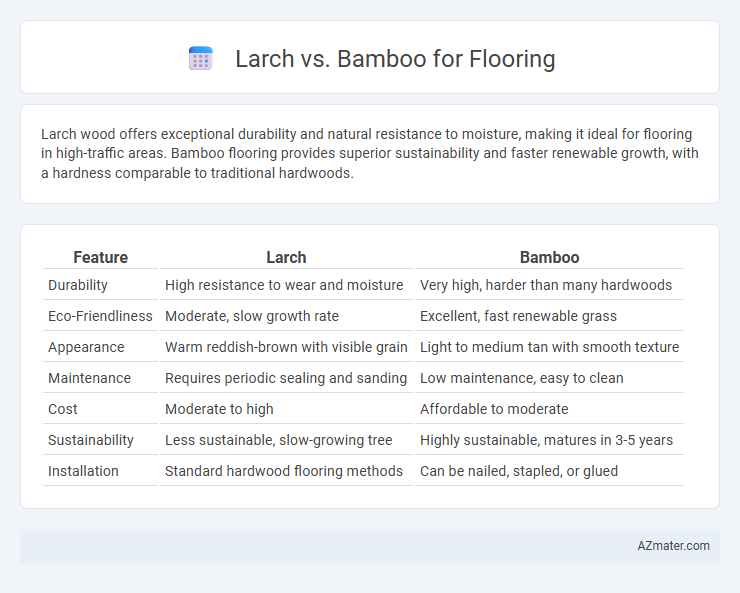Larch wood offers exceptional durability and natural resistance to moisture, making it ideal for flooring in high-traffic areas. Bamboo flooring provides superior sustainability and faster renewable growth, with a hardness comparable to traditional hardwoods.
Table of Comparison
| Feature | Larch | Bamboo |
|---|---|---|
| Durability | High resistance to wear and moisture | Very high, harder than many hardwoods |
| Eco-Friendliness | Moderate, slow growth rate | Excellent, fast renewable grass |
| Appearance | Warm reddish-brown with visible grain | Light to medium tan with smooth texture |
| Maintenance | Requires periodic sealing and sanding | Low maintenance, easy to clean |
| Cost | Moderate to high | Affordable to moderate |
| Sustainability | Less sustainable, slow-growing tree | Highly sustainable, matures in 3-5 years |
| Installation | Standard hardwood flooring methods | Can be nailed, stapled, or glued |
Introduction to Larch and Bamboo Flooring
Larch flooring, derived from the durable larch tree, offers a dense grain structure and exceptional resistance to moisture, making it ideal for high-traffic and humid areas. Bamboo flooring is a rapidly renewable resource known for its strength, hardness, and distinctive natural aesthetics, often outperforming traditional hardwoods in terms of sustainability. Both options provide eco-friendly alternatives, with larch showcasing a warm reddish hue and bamboo offering a sleek, contemporary finish suitable for various interior styles.
Appearance and Aesthetic Differences
Larch flooring features distinctive warm reddish-brown tones and prominent grain patterns, offering a rustic and natural aesthetic suitable for cozy, traditional interiors. Bamboo flooring presents a sleek, contemporary look with smooth texture and consistent light to medium honey hues, often appealing to modern and minimalist designs. The contrasting appearances make larch ideal for adding character and warmth, while bamboo emphasizes clean lines and uniformity in flooring aesthetics.
Durability and Hardness Comparison
Larch flooring offers superior durability due to its dense grain structure and natural resistance to moisture, making it ideal for high-traffic areas. Bamboo flooring demonstrates exceptional hardness, often ranking higher on the Janka hardness scale than many hardwoods, including larch, resulting in enhanced scratch and dent resistance. Both materials provide long-lasting performance, but bamboo's rapid renewability also contributes to its sustainability appeal in durable flooring options.
Sustainability and Environmental Impact
Larch flooring offers a highly sustainable option due to its rapid growth rate and carbon sequestration capabilities, while bamboo flooring is renowned for its renewable harvest cycle of 3-5 years, making it one of the fastest-growing plants on Earth. Both materials are biodegradable and have lower VOC emissions compared to synthetic flooring alternatives, contributing positively to indoor air quality. Bamboo's energy-intensive manufacturing process can offset some environmental benefits, whereas larch's natural durability often reduces the need for chemical treatments, enhancing its eco-friendliness.
Installation Process: Larch vs Bamboo
Larch flooring typically requires professional installation due to its dense, resin-rich composition, often necessitating specialized tools for precise cutting and fitting. Bamboo flooring, known for its uniformity and dimensional stability, allows for easier installation methods such as click-lock or floating floors, making it more suitable for DIY projects. Both materials benefit from moisture control during installation, but bamboo's quicker acclimation time often results in faster project completion.
Maintenance and Care Requirements
Larch flooring offers moderate maintenance with periodic sealing and polishing necessary to preserve its natural hardness and water resistance, making it suitable for indoor areas with moderate foot traffic. Bamboo flooring demands minimal upkeep, requiring regular sweeping or vacuuming and occasional damp mopping, benefiting from its inherent durability and resistance to moisture and insects. Both materials benefit from protective treatments against scratches and humidity, but bamboo's faster growth cycle also contributes to its sustainability as a low-maintenance flooring option.
Cost and Value Analysis
Larch flooring offers moderate cost efficiency with prices typically ranging from $4 to $8 per square foot, providing durability and a distinctive reddish tone that adds aesthetic value to interiors. Bamboo flooring, often priced between $3 and $7 per square foot, presents an eco-friendly, rapidly renewable resource option with comparable hardness and moisture resistance. Evaluating long-term value, bamboo's sustainability and resilience make it a cost-effective choice for environmentally conscious consumers, while larch's unique grain and robustness contribute to a classic, high-end appeal.
Moisture Resistance and Stability
Larch wood offers moderate moisture resistance due to its natural resin content, making it more stable in humid conditions compared to many softwoods but less so than bamboo. Bamboo flooring excels in moisture resistance and dimensional stability because of its dense fiber structure and the manufacturing process, which often includes carbonization and compression. This superior resistance to moisture and stability makes bamboo a preferred choice for areas prone to humidity fluctuations.
Common Applications and Suitability
Larch wood, known for its durability and resistance to moisture, is commonly used in flooring applications that require robustness and natural aesthetics, such as rustic cabins and outdoor patios. Bamboo flooring excels in eco-friendly, high-traffic indoor spaces due to its rapid renewability, hardness, and sleek, modern appearance. Both materials are suitable for residential and commercial flooring, but larch is ideal for damp environments while bamboo offers superior sustainability and a contemporary look.
Conclusion: Which Flooring Is Right for You?
Larch flooring offers exceptional durability and water resistance, ideal for high-traffic or moisture-prone areas, while bamboo provides a sustainable, fast-growing option with a sleek, modern aesthetic and excellent hardness comparable to hardwoods. Bamboo flooring tends to be more affordable and eco-friendly, suited for those prioritizing sustainability and cost, whereas larch's natural rustic appeal and resilience make it perfect for traditional or rustic interior designs. Your choice depends on whether you value environmental impact, cost efficiency, or a specific style and durability profile for your flooring needs.

Infographic: Larch vs Bamboo for Flooring
 azmater.com
azmater.com